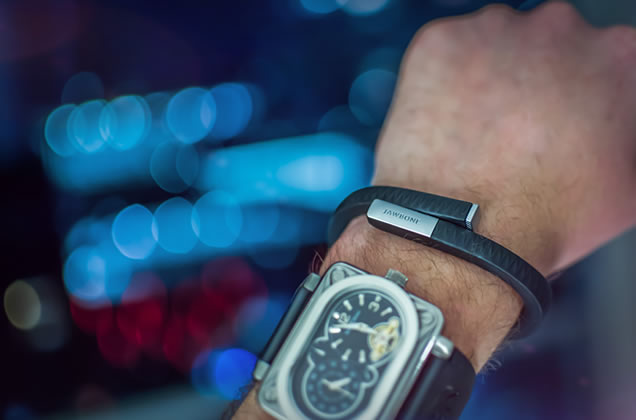A little while ago, a friend of mine introduced me to the brave new(ish) world of personal fitness and health bands. As I was on a health kick at the time – it comes and goes, don’t judge – and because I found a coupon, I decided to take the plunge. From day one I became obsessed with my daily steps moved and how well or not I’d slept. There are many aspects of these devices that are undoubtedly useful for those wishing to follow a regime of health and/or fitness but which ones will give you a run for your money?
I’ll be looking specifically at the de facto top three of such devices, as it’s likely you’ll be interested in these instead of the tens of others cropping up on the market recently. There are sexy new items coming up all the time, such as Samsung’s new offering, the Gear Fit, but unless I get one to use in a review (massive hint to Samsung) I’ll stick to the current big players.
Jawbone UP: Of all the trackers and monitors around, this is the one I use and therefore the one I see people wearing most often. Its role is that of counting the number of steps you take during the day and how well you are sleeping. The idea of step counting is to improve what UK medical people call NEAT – Non-Exercise Activity Thermogenesis. Put simply, if you move more, you burn more calories. Take one or two flights of stairs instead of a lift, walk to or from work instead of getting the bus, that sort of thing. UP achieves these data using a technology called MotionX, a similar thing to the accelerometer in your phone but a bit smarter. You can also manually add an exercise session to the day’s data and use it to track what you’re eating – and thus the calories via a barcode scanner. A nice feature is its movement alarm. If you’re sitting at a desk all day, you can set a time of inactivity after which the band will buzz, reminding you to get up and about for a while.
Fitbit Flex: Fitbit had something of a PR meltdown in recent weeks, as their recent device, the Fitbit Force was found to be causing some quite unpleasant skin irritation, obliging the company to recall and refund some one and a quarter million units. They are hoping to rebound from this and have the Force on sale again soon. Currently, their Flex is the thing to have. The Flex will track your movement, calculate calories burned and collect sleep statistics. Like the UP, it will also use its accelerometer to monitor your sleep patterns and wake you up at the most beneficial time during your sleep cycle, helping you avoid at least some of the horrors of a Monday morning. Currently, the Flex is cheaper than the UP, presumably until the new Force is out in the wild. This might be a good time to take advantage.
Nike FuelBand SE: Aware of some people’s dislike or distrust of raw data, Nike have tried to be different and converted all this activity into NikeFuel. The cynical might say that it’s a way of branding calorie counting but not me, oh no. The NikeFuel business won’t put anyone off though. The unit is a thing of beauty and as attractive as Hollywood’s next big thing. It has a dual-colour design but in a way in which the colours bleed into each other. It really does look nice. Better yet is the LED display that’s integrated into the form of the band itself requiring no screen or other unnecessary bulk. The downsides, however, are many. It has the lowest rate of app compatibility of all the top bands and is the most expensive by some 30 or 40 euros. The deal breaker for many people, however, will be the lack of a dedicated app for Android. Whether Apple likes it or not, Android outsells them over 2 to 1 and getting into bed with Nike will do neither any favours.
If you’re looking for a band and have an iPhone or an iPad, you have three to choose from, otherwise, the market really seems to be sewn up between Fitbit and Jawbone, with very little to separate them, save for the Fitbit’s more attractive price. Using either of these, you can easily sync with other fitness apps such as the popular MapMyFitness, RunKeeper and Strava. This symbiosis with free apps makes the UP and the Flex my two top contenders for the title – at least in this early part of the year.
As fitness bands become more main-stream, more apps are being designed to take advantage of them and in turn, the bands can only get more intelligent. The market is looking very healthy indeed.







